Social Network Sites & Brands and/or Brand Communities
VerifiedAdded on 2023/06/14
|10
|2179
|142
AI Summary
This study explores the impact of social network sites and brand communities on customer loyalty and trust. It discusses the challenges faced by marketers and the benefits of engaging with customers through social media.
Contribute Materials
Your contribution can guide someone’s learning journey. Share your
documents today.
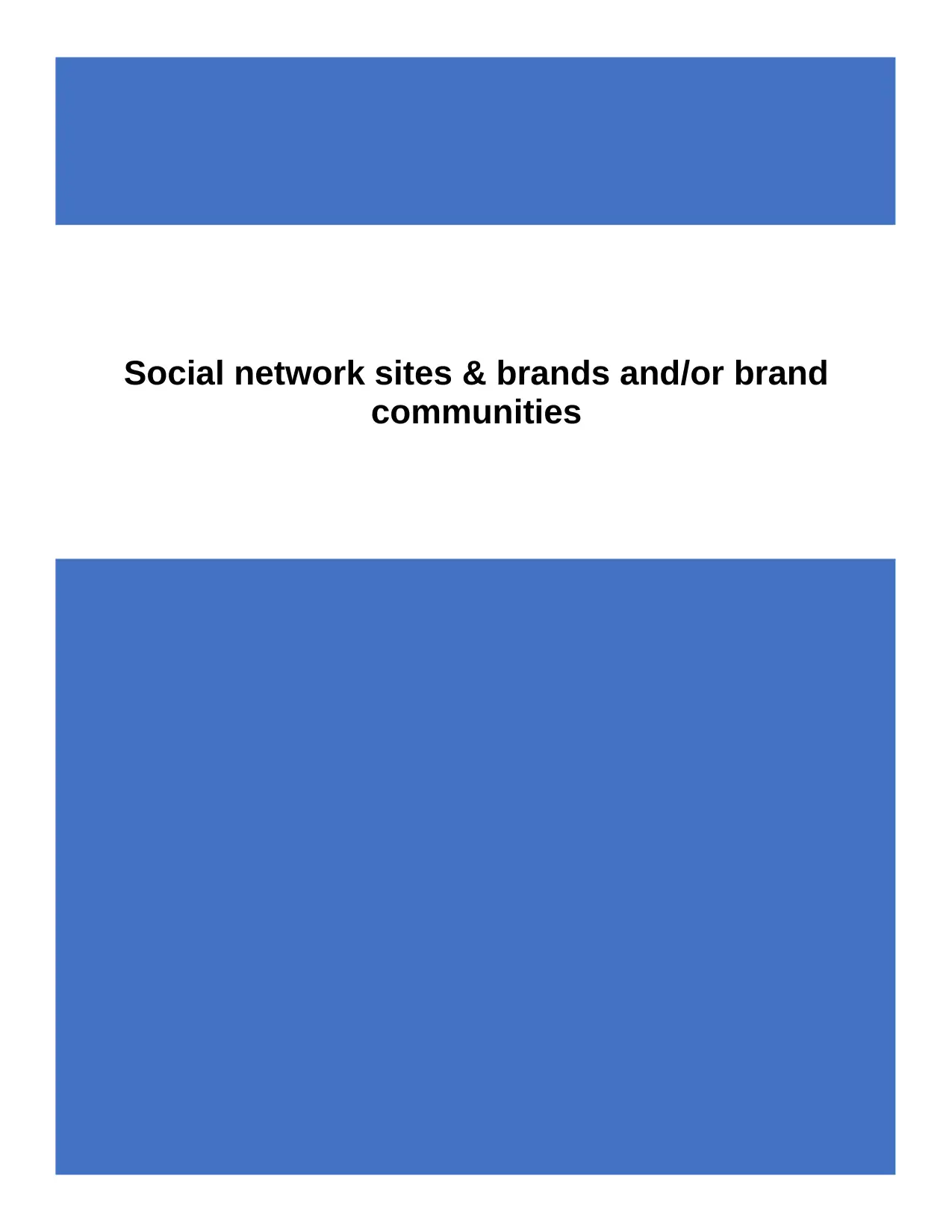
Social network sites & brands and/or brand
communities
communities
Secure Best Marks with AI Grader
Need help grading? Try our AI Grader for instant feedback on your assignments.
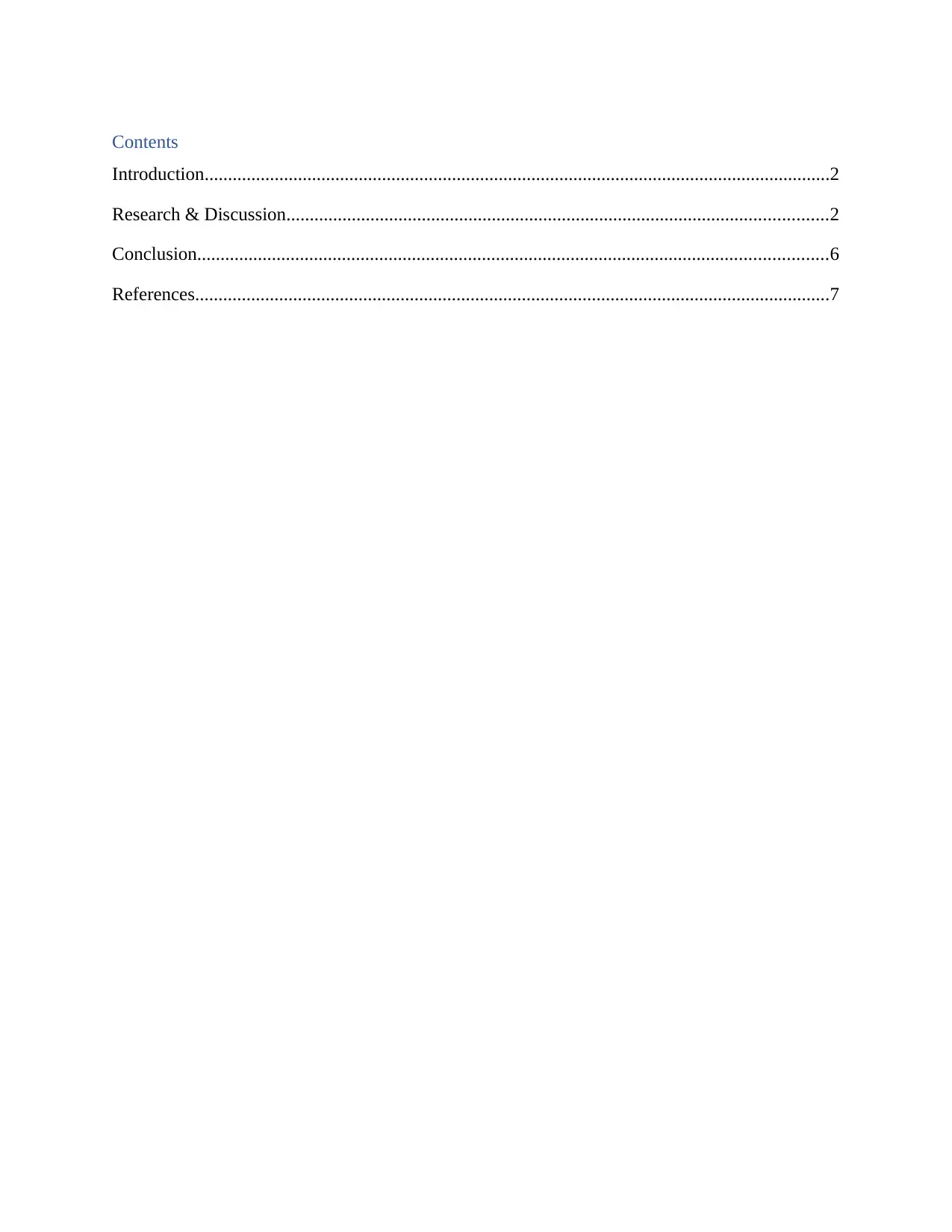
Contents
Introduction......................................................................................................................................2
Research & Discussion....................................................................................................................2
Conclusion.......................................................................................................................................6
References........................................................................................................................................7
Introduction......................................................................................................................................2
Research & Discussion....................................................................................................................2
Conclusion.......................................................................................................................................6
References........................................................................................................................................7
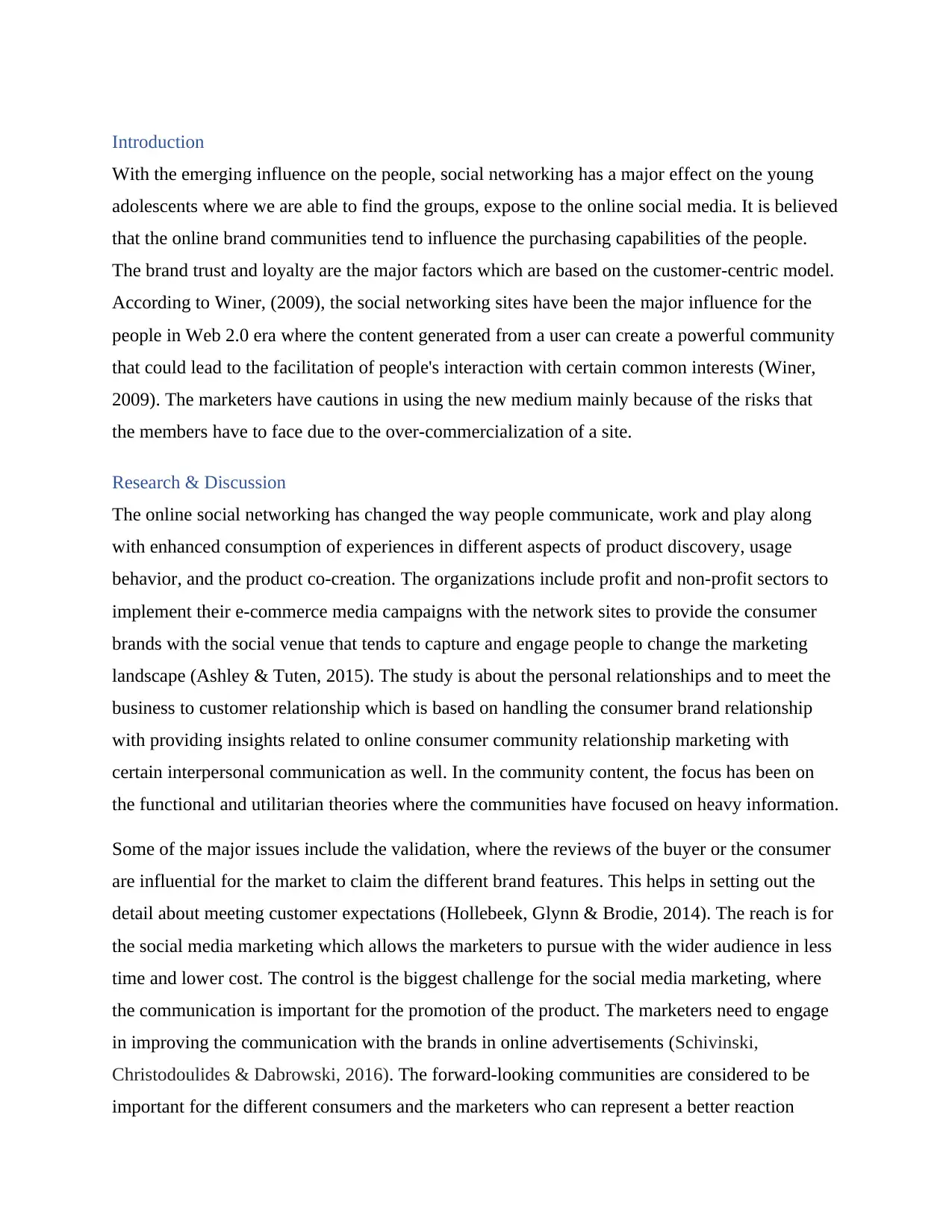
Introduction
With the emerging influence on the people, social networking has a major effect on the young
adolescents where we are able to find the groups, expose to the online social media. It is believed
that the online brand communities tend to influence the purchasing capabilities of the people.
The brand trust and loyalty are the major factors which are based on the customer-centric model.
According to Winer, (2009), the social networking sites have been the major influence for the
people in Web 2.0 era where the content generated from a user can create a powerful community
that could lead to the facilitation of people's interaction with certain common interests (Winer,
2009). The marketers have cautions in using the new medium mainly because of the risks that
the members have to face due to the over-commercialization of a site.
Research & Discussion
The online social networking has changed the way people communicate, work and play along
with enhanced consumption of experiences in different aspects of product discovery, usage
behavior, and the product co-creation. The organizations include profit and non-profit sectors to
implement their e-commerce media campaigns with the network sites to provide the consumer
brands with the social venue that tends to capture and engage people to change the marketing
landscape (Ashley & Tuten, 2015). The study is about the personal relationships and to meet the
business to customer relationship which is based on handling the consumer brand relationship
with providing insights related to online consumer community relationship marketing with
certain interpersonal communication as well. In the community content, the focus has been on
the functional and utilitarian theories where the communities have focused on heavy information.
Some of the major issues include the validation, where the reviews of the buyer or the consumer
are influential for the market to claim the different brand features. This helps in setting out the
detail about meeting customer expectations (Hollebeek, Glynn & Brodie, 2014). The reach is for
the social media marketing which allows the marketers to pursue with the wider audience in less
time and lower cost. The control is the biggest challenge for the social media marketing, where
the communication is important for the promotion of the product. The marketers need to engage
in improving the communication with the brands in online advertisements (Schivinski,
Christodoulides & Dabrowski, 2016). The forward-looking communities are considered to be
important for the different consumers and the marketers who can represent a better reaction
With the emerging influence on the people, social networking has a major effect on the young
adolescents where we are able to find the groups, expose to the online social media. It is believed
that the online brand communities tend to influence the purchasing capabilities of the people.
The brand trust and loyalty are the major factors which are based on the customer-centric model.
According to Winer, (2009), the social networking sites have been the major influence for the
people in Web 2.0 era where the content generated from a user can create a powerful community
that could lead to the facilitation of people's interaction with certain common interests (Winer,
2009). The marketers have cautions in using the new medium mainly because of the risks that
the members have to face due to the over-commercialization of a site.
Research & Discussion
The online social networking has changed the way people communicate, work and play along
with enhanced consumption of experiences in different aspects of product discovery, usage
behavior, and the product co-creation. The organizations include profit and non-profit sectors to
implement their e-commerce media campaigns with the network sites to provide the consumer
brands with the social venue that tends to capture and engage people to change the marketing
landscape (Ashley & Tuten, 2015). The study is about the personal relationships and to meet the
business to customer relationship which is based on handling the consumer brand relationship
with providing insights related to online consumer community relationship marketing with
certain interpersonal communication as well. In the community content, the focus has been on
the functional and utilitarian theories where the communities have focused on heavy information.
Some of the major issues include the validation, where the reviews of the buyer or the consumer
are influential for the market to claim the different brand features. This helps in setting out the
detail about meeting customer expectations (Hollebeek, Glynn & Brodie, 2014). The reach is for
the social media marketing which allows the marketers to pursue with the wider audience in less
time and lower cost. The control is the biggest challenge for the social media marketing, where
the communication is important for the promotion of the product. The marketers need to engage
in improving the communication with the brands in online advertisements (Schivinski,
Christodoulides & Dabrowski, 2016). The forward-looking communities are considered to be
important for the different consumers and the marketers who can represent a better reaction
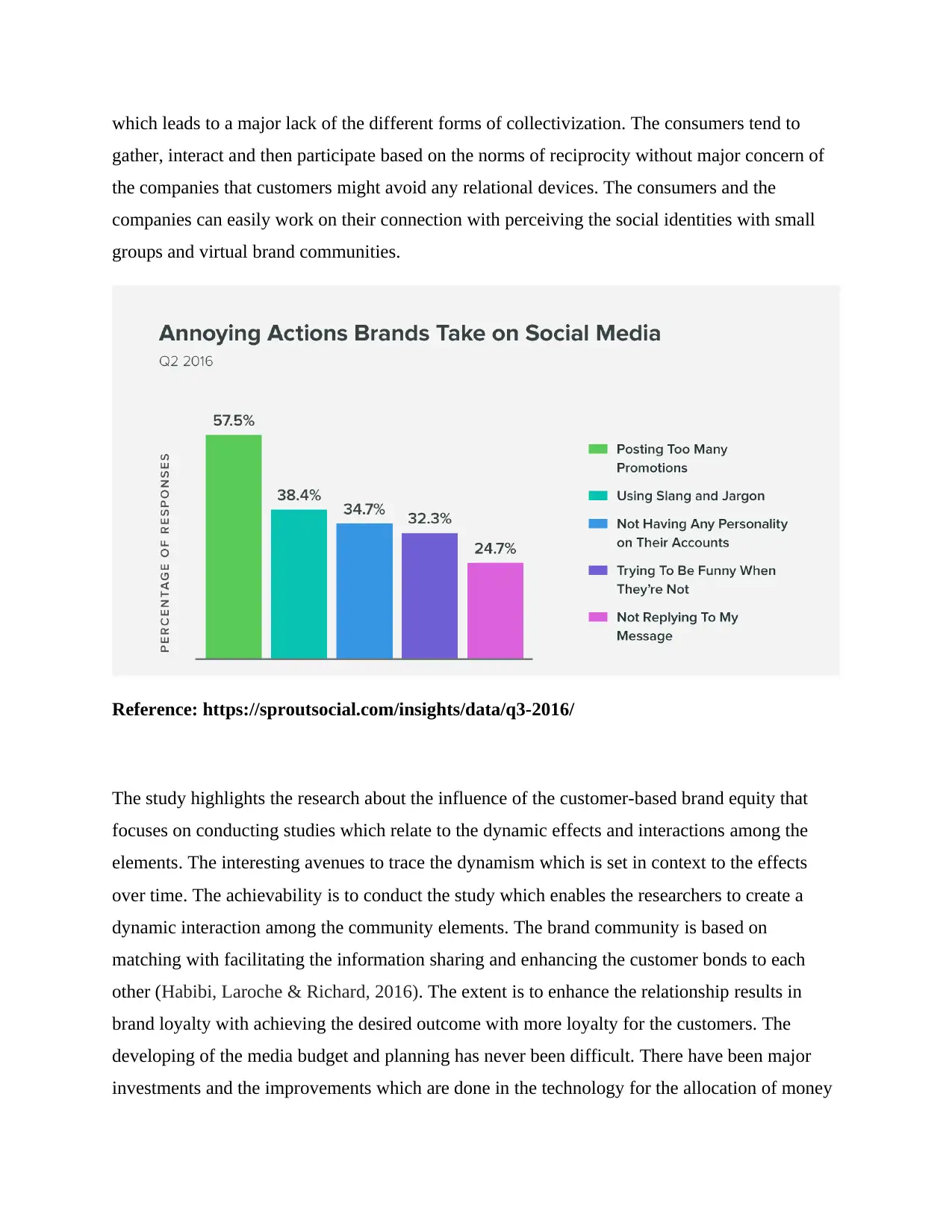
which leads to a major lack of the different forms of collectivization. The consumers tend to
gather, interact and then participate based on the norms of reciprocity without major concern of
the companies that customers might avoid any relational devices. The consumers and the
companies can easily work on their connection with perceiving the social identities with small
groups and virtual brand communities.
Reference: https://sproutsocial.com/insights/data/q3-2016/
The study highlights the research about the influence of the customer-based brand equity that
focuses on conducting studies which relate to the dynamic effects and interactions among the
elements. The interesting avenues to trace the dynamism which is set in context to the effects
over time. The achievability is to conduct the study which enables the researchers to create a
dynamic interaction among the community elements. The brand community is based on
matching with facilitating the information sharing and enhancing the customer bonds to each
other (Habibi, Laroche & Richard, 2016). The extent is to enhance the relationship results in
brand loyalty with achieving the desired outcome with more loyalty for the customers. The
developing of the media budget and planning has never been difficult. There have been major
investments and the improvements which are done in the technology for the allocation of money
gather, interact and then participate based on the norms of reciprocity without major concern of
the companies that customers might avoid any relational devices. The consumers and the
companies can easily work on their connection with perceiving the social identities with small
groups and virtual brand communities.
Reference: https://sproutsocial.com/insights/data/q3-2016/
The study highlights the research about the influence of the customer-based brand equity that
focuses on conducting studies which relate to the dynamic effects and interactions among the
elements. The interesting avenues to trace the dynamism which is set in context to the effects
over time. The achievability is to conduct the study which enables the researchers to create a
dynamic interaction among the community elements. The brand community is based on
matching with facilitating the information sharing and enhancing the customer bonds to each
other (Habibi, Laroche & Richard, 2016). The extent is to enhance the relationship results in
brand loyalty with achieving the desired outcome with more loyalty for the customers. The
developing of the media budget and planning has never been difficult. There have been major
investments and the improvements which are done in the technology for the allocation of money
Secure Best Marks with AI Grader
Need help grading? Try our AI Grader for instant feedback on your assignments.
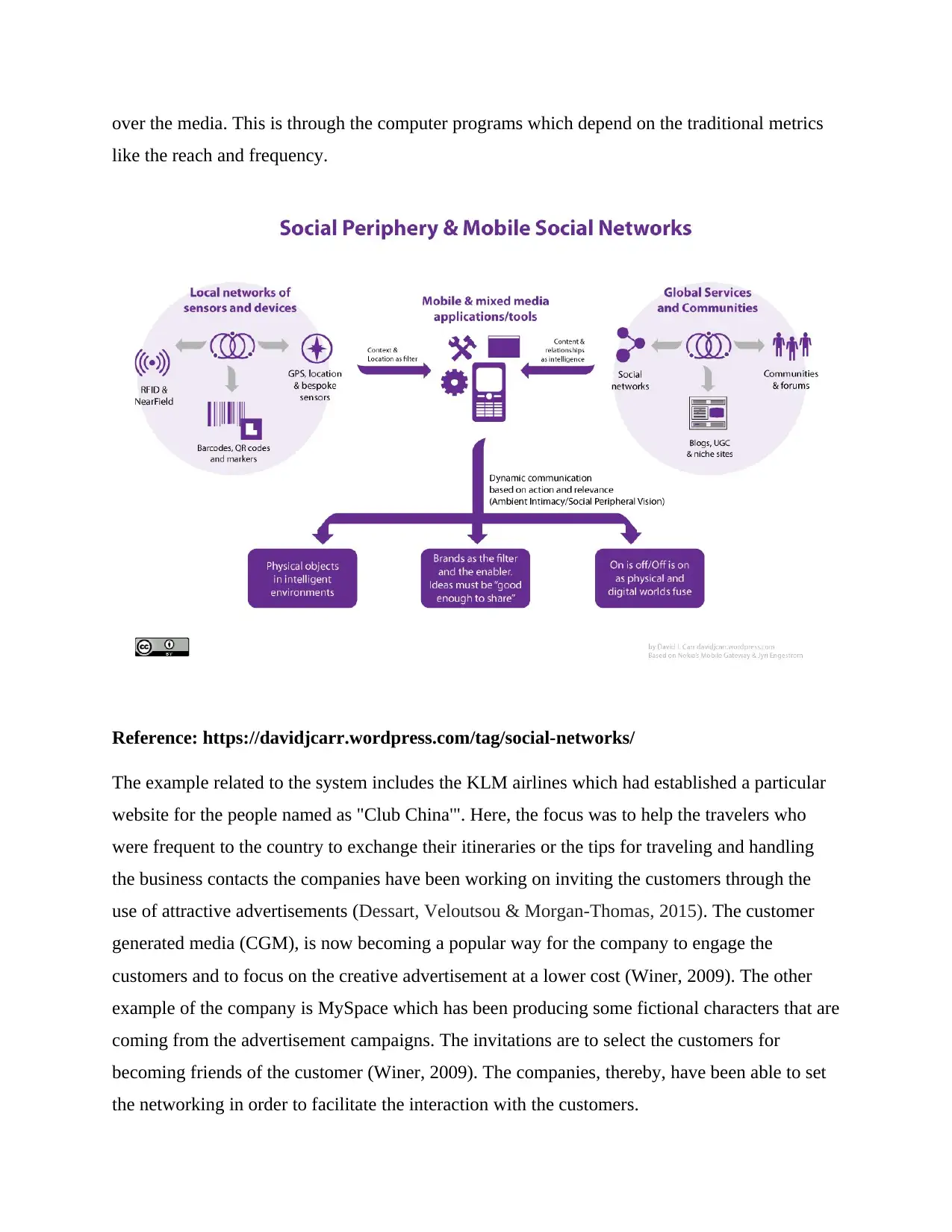
over the media. This is through the computer programs which depend on the traditional metrics
like the reach and frequency.
Reference: https://davidjcarr.wordpress.com/tag/social-networks/
The example related to the system includes the KLM airlines which had established a particular
website for the people named as "Club China'". Here, the focus was to help the travelers who
were frequent to the country to exchange their itineraries or the tips for traveling and handling
the business contacts the companies have been working on inviting the customers through the
use of attractive advertisements (Dessart, Veloutsou & Morgan-Thomas, 2015). The customer
generated media (CGM), is now becoming a popular way for the company to engage the
customers and to focus on the creative advertisement at a lower cost (Winer, 2009). The other
example of the company is MySpace which has been producing some fictional characters that are
coming from the advertisement campaigns. The invitations are to select the customers for
becoming friends of the customer (Winer, 2009). The companies, thereby, have been able to set
the networking in order to facilitate the interaction with the customers.
like the reach and frequency.
Reference: https://davidjcarr.wordpress.com/tag/social-networks/
The example related to the system includes the KLM airlines which had established a particular
website for the people named as "Club China'". Here, the focus was to help the travelers who
were frequent to the country to exchange their itineraries or the tips for traveling and handling
the business contacts the companies have been working on inviting the customers through the
use of attractive advertisements (Dessart, Veloutsou & Morgan-Thomas, 2015). The customer
generated media (CGM), is now becoming a popular way for the company to engage the
customers and to focus on the creative advertisement at a lower cost (Winer, 2009). The other
example of the company is MySpace which has been producing some fictional characters that are
coming from the advertisement campaigns. The invitations are to select the customers for
becoming friends of the customer (Winer, 2009). The companies, thereby, have been able to set
the networking in order to facilitate the interaction with the customers.
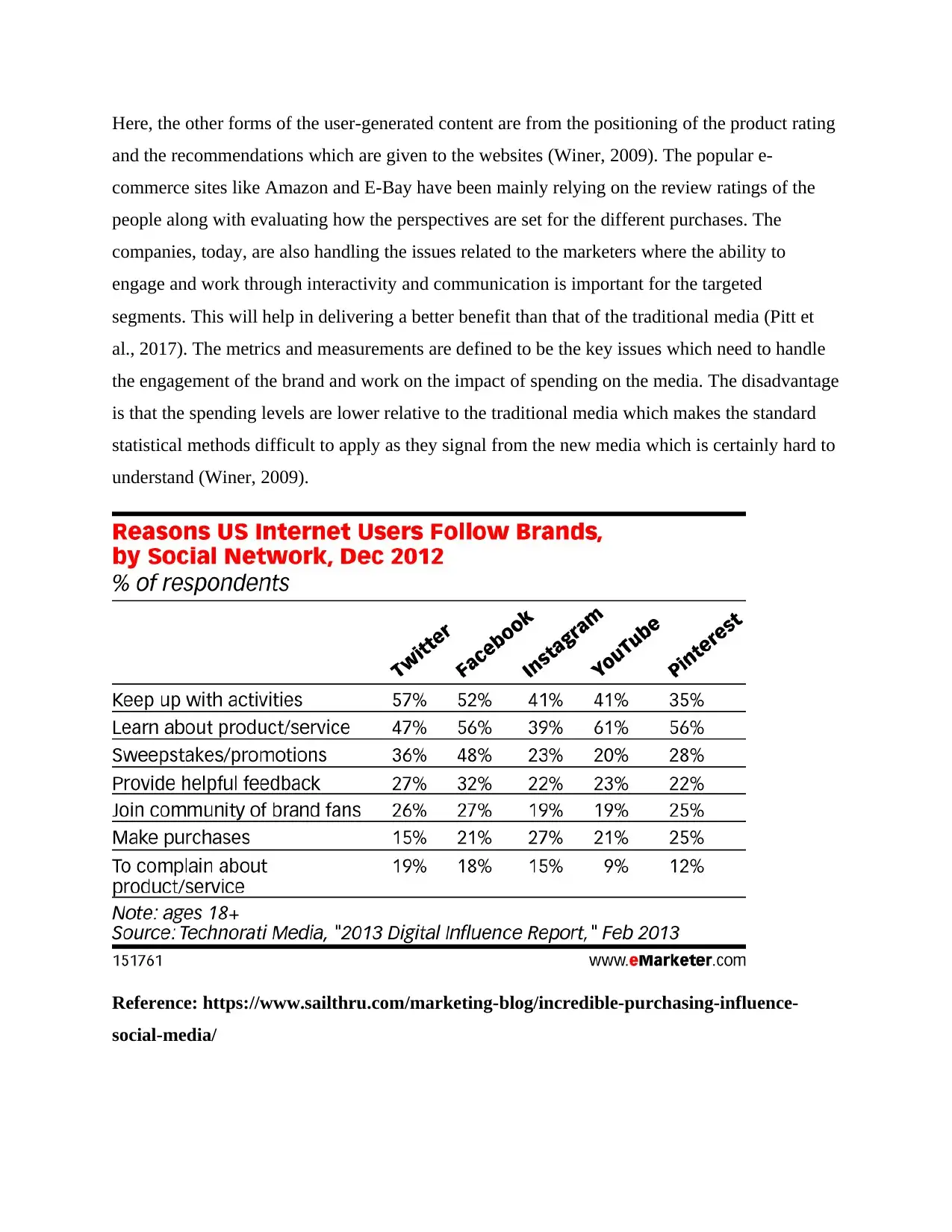
Here, the other forms of the user-generated content are from the positioning of the product rating
and the recommendations which are given to the websites (Winer, 2009). The popular e-
commerce sites like Amazon and E-Bay have been mainly relying on the review ratings of the
people along with evaluating how the perspectives are set for the different purchases. The
companies, today, are also handling the issues related to the marketers where the ability to
engage and work through interactivity and communication is important for the targeted
segments. This will help in delivering a better benefit than that of the traditional media (Pitt et
al., 2017). The metrics and measurements are defined to be the key issues which need to handle
the engagement of the brand and work on the impact of spending on the media. The disadvantage
is that the spending levels are lower relative to the traditional media which makes the standard
statistical methods difficult to apply as they signal from the new media which is certainly hard to
understand (Winer, 2009).
Reference: https://www.sailthru.com/marketing-blog/incredible-purchasing-influence-
social-media/
and the recommendations which are given to the websites (Winer, 2009). The popular e-
commerce sites like Amazon and E-Bay have been mainly relying on the review ratings of the
people along with evaluating how the perspectives are set for the different purchases. The
companies, today, are also handling the issues related to the marketers where the ability to
engage and work through interactivity and communication is important for the targeted
segments. This will help in delivering a better benefit than that of the traditional media (Pitt et
al., 2017). The metrics and measurements are defined to be the key issues which need to handle
the engagement of the brand and work on the impact of spending on the media. The disadvantage
is that the spending levels are lower relative to the traditional media which makes the standard
statistical methods difficult to apply as they signal from the new media which is certainly hard to
understand (Winer, 2009).
Reference: https://www.sailthru.com/marketing-blog/incredible-purchasing-influence-
social-media/
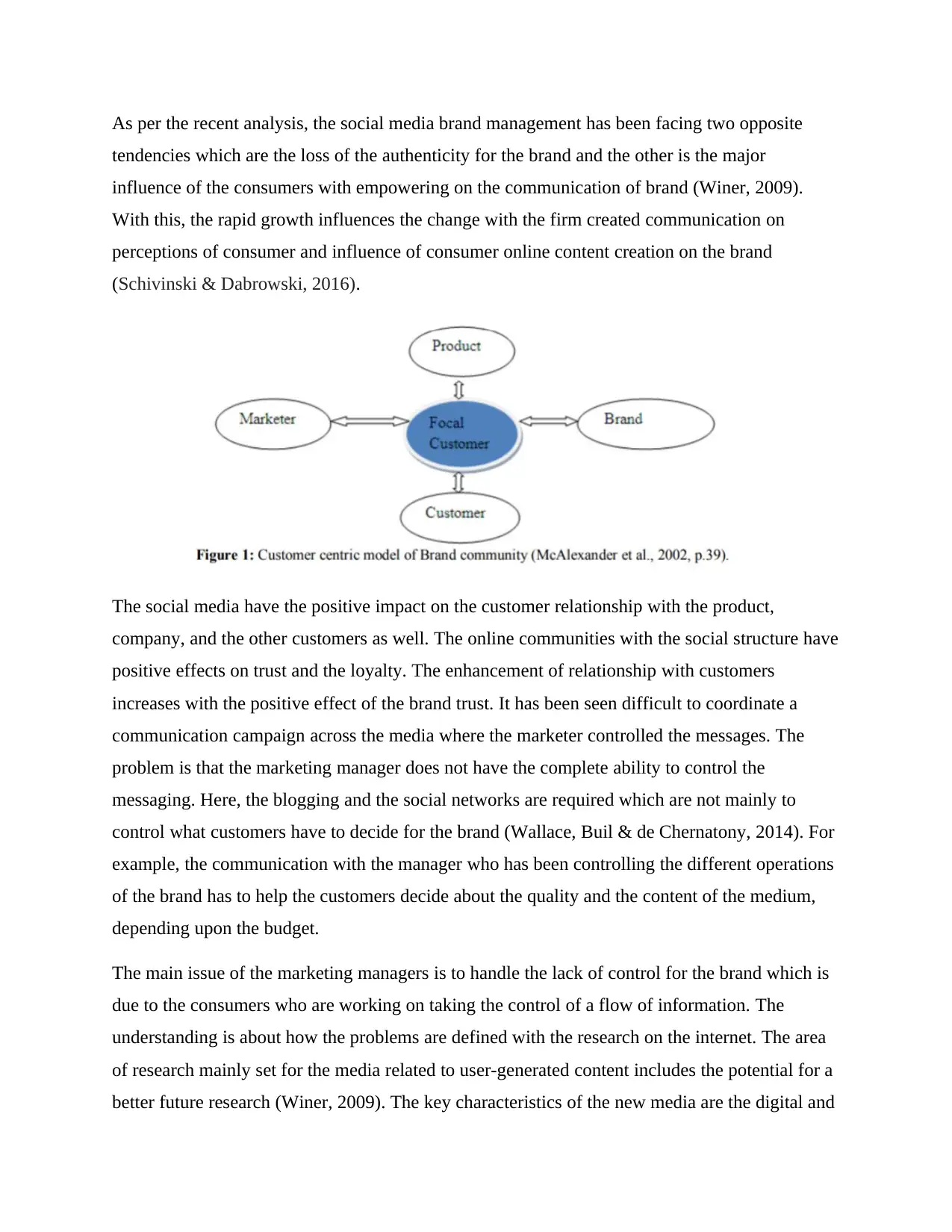
As per the recent analysis, the social media brand management has been facing two opposite
tendencies which are the loss of the authenticity for the brand and the other is the major
influence of the consumers with empowering on the communication of brand (Winer, 2009).
With this, the rapid growth influences the change with the firm created communication on
perceptions of consumer and influence of consumer online content creation on the brand
(Schivinski & Dabrowski, 2016).
The social media have the positive impact on the customer relationship with the product,
company, and the other customers as well. The online communities with the social structure have
positive effects on trust and the loyalty. The enhancement of relationship with customers
increases with the positive effect of the brand trust. It has been seen difficult to coordinate a
communication campaign across the media where the marketer controlled the messages. The
problem is that the marketing manager does not have the complete ability to control the
messaging. Here, the blogging and the social networks are required which are not mainly to
control what customers have to decide for the brand (Wallace, Buil & de Chernatony, 2014). For
example, the communication with the manager who has been controlling the different operations
of the brand has to help the customers decide about the quality and the content of the medium,
depending upon the budget.
The main issue of the marketing managers is to handle the lack of control for the brand which is
due to the consumers who are working on taking the control of a flow of information. The
understanding is about how the problems are defined with the research on the internet. The area
of research mainly set for the media related to user-generated content includes the potential for a
better future research (Winer, 2009). The key characteristics of the new media are the digital and
tendencies which are the loss of the authenticity for the brand and the other is the major
influence of the consumers with empowering on the communication of brand (Winer, 2009).
With this, the rapid growth influences the change with the firm created communication on
perceptions of consumer and influence of consumer online content creation on the brand
(Schivinski & Dabrowski, 2016).
The social media have the positive impact on the customer relationship with the product,
company, and the other customers as well. The online communities with the social structure have
positive effects on trust and the loyalty. The enhancement of relationship with customers
increases with the positive effect of the brand trust. It has been seen difficult to coordinate a
communication campaign across the media where the marketer controlled the messages. The
problem is that the marketing manager does not have the complete ability to control the
messaging. Here, the blogging and the social networks are required which are not mainly to
control what customers have to decide for the brand (Wallace, Buil & de Chernatony, 2014). For
example, the communication with the manager who has been controlling the different operations
of the brand has to help the customers decide about the quality and the content of the medium,
depending upon the budget.
The main issue of the marketing managers is to handle the lack of control for the brand which is
due to the consumers who are working on taking the control of a flow of information. The
understanding is about how the problems are defined with the research on the internet. The area
of research mainly set for the media related to user-generated content includes the potential for a
better future research (Winer, 2009). The key characteristics of the new media are the digital and
Paraphrase This Document
Need a fresh take? Get an instant paraphrase of this document with our AI Paraphraser
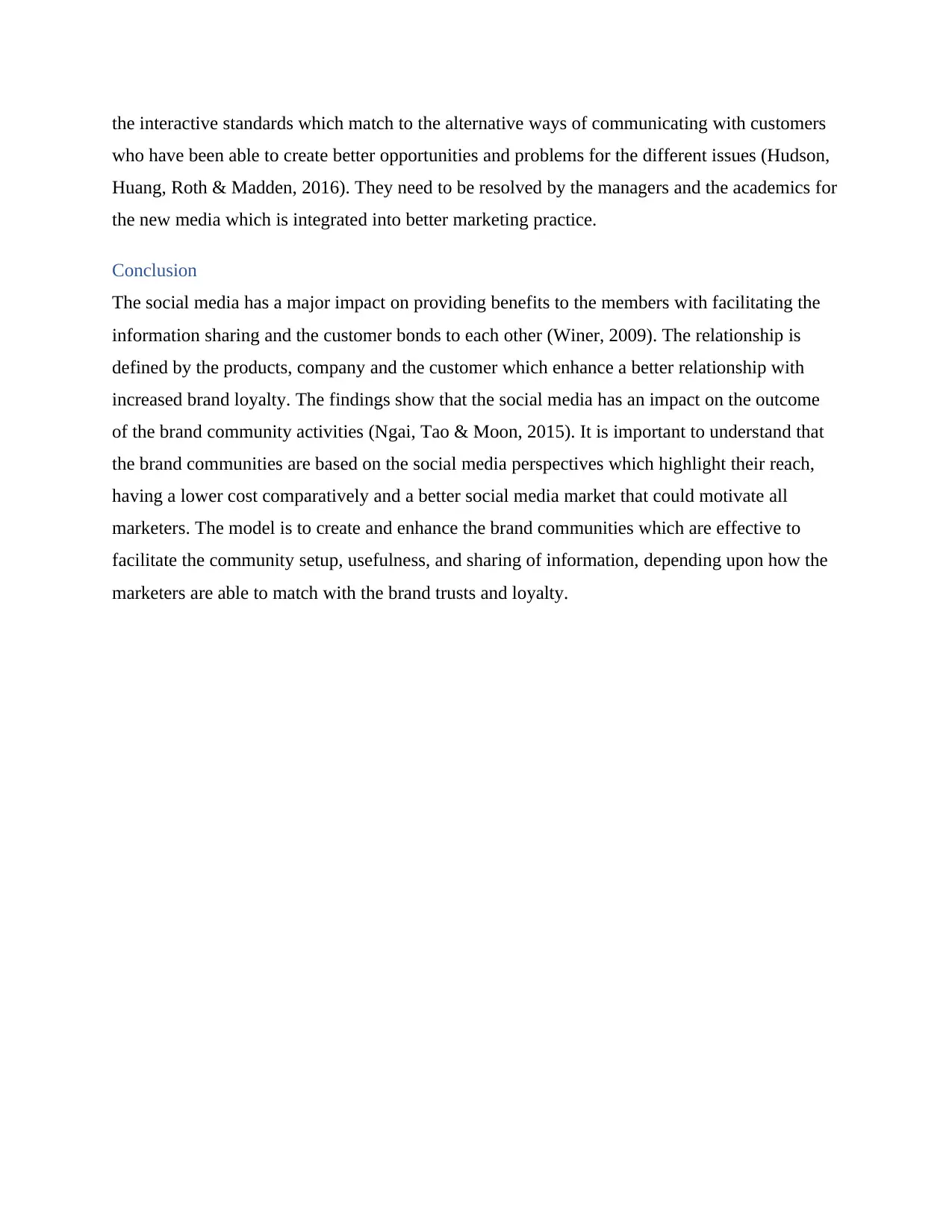
the interactive standards which match to the alternative ways of communicating with customers
who have been able to create better opportunities and problems for the different issues (Hudson,
Huang, Roth & Madden, 2016). They need to be resolved by the managers and the academics for
the new media which is integrated into better marketing practice.
Conclusion
The social media has a major impact on providing benefits to the members with facilitating the
information sharing and the customer bonds to each other (Winer, 2009). The relationship is
defined by the products, company and the customer which enhance a better relationship with
increased brand loyalty. The findings show that the social media has an impact on the outcome
of the brand community activities (Ngai, Tao & Moon, 2015). It is important to understand that
the brand communities are based on the social media perspectives which highlight their reach,
having a lower cost comparatively and a better social media market that could motivate all
marketers. The model is to create and enhance the brand communities which are effective to
facilitate the community setup, usefulness, and sharing of information, depending upon how the
marketers are able to match with the brand trusts and loyalty.
who have been able to create better opportunities and problems for the different issues (Hudson,
Huang, Roth & Madden, 2016). They need to be resolved by the managers and the academics for
the new media which is integrated into better marketing practice.
Conclusion
The social media has a major impact on providing benefits to the members with facilitating the
information sharing and the customer bonds to each other (Winer, 2009). The relationship is
defined by the products, company and the customer which enhance a better relationship with
increased brand loyalty. The findings show that the social media has an impact on the outcome
of the brand community activities (Ngai, Tao & Moon, 2015). It is important to understand that
the brand communities are based on the social media perspectives which highlight their reach,
having a lower cost comparatively and a better social media market that could motivate all
marketers. The model is to create and enhance the brand communities which are effective to
facilitate the community setup, usefulness, and sharing of information, depending upon how the
marketers are able to match with the brand trusts and loyalty.
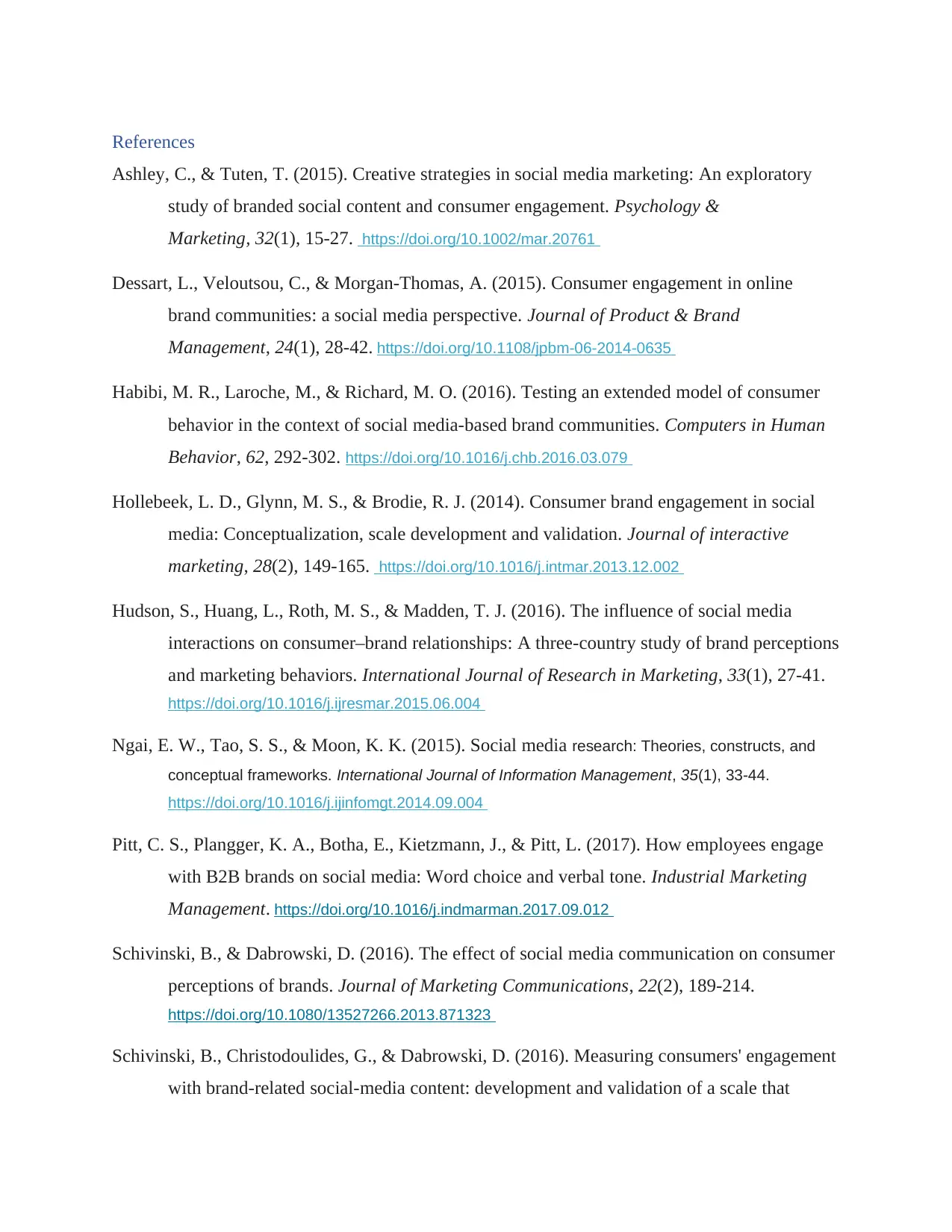
References
Ashley, C., & Tuten, T. (2015). Creative strategies in social media marketing: An exploratory
study of branded social content and consumer engagement. Psychology &
Marketing, 32(1), 15-27. https://doi.org/10.1002/mar.20761
Dessart, L., Veloutsou, C., & Morgan-Thomas, A. (2015). Consumer engagement in online
brand communities: a social media perspective. Journal of Product & Brand
Management, 24(1), 28-42. https://doi.org/10.1108/jpbm-06-2014-0635
Habibi, M. R., Laroche, M., & Richard, M. O. (2016). Testing an extended model of consumer
behavior in the context of social media-based brand communities. Computers in Human
Behavior, 62, 292-302. https://doi.org/10.1016/j.chb.2016.03.079
Hollebeek, L. D., Glynn, M. S., & Brodie, R. J. (2014). Consumer brand engagement in social
media: Conceptualization, scale development and validation. Journal of interactive
marketing, 28(2), 149-165. https://doi.org/10.1016/j.intmar.2013.12.002
Hudson, S., Huang, L., Roth, M. S., & Madden, T. J. (2016). The influence of social media
interactions on consumer–brand relationships: A three-country study of brand perceptions
and marketing behaviors. International Journal of Research in Marketing, 33(1), 27-41.
https://doi.org/10.1016/j.ijresmar.2015.06.004
Ngai, E. W., Tao, S. S., & Moon, K. K. (2015). Social media research: Theories, constructs, and
conceptual frameworks. International Journal of Information Management, 35(1), 33-44.
https://doi.org/10.1016/j.ijinfomgt.2014.09.004
Pitt, C. S., Plangger, K. A., Botha, E., Kietzmann, J., & Pitt, L. (2017). How employees engage
with B2B brands on social media: Word choice and verbal tone. Industrial Marketing
Management. https://doi.org/10.1016/j.indmarman.2017.09.012
Schivinski, B., & Dabrowski, D. (2016). The effect of social media communication on consumer
perceptions of brands. Journal of Marketing Communications, 22(2), 189-214.
https://doi.org/10.1080/13527266.2013.871323
Schivinski, B., Christodoulides, G., & Dabrowski, D. (2016). Measuring consumers' engagement
with brand-related social-media content: development and validation of a scale that
Ashley, C., & Tuten, T. (2015). Creative strategies in social media marketing: An exploratory
study of branded social content and consumer engagement. Psychology &
Marketing, 32(1), 15-27. https://doi.org/10.1002/mar.20761
Dessart, L., Veloutsou, C., & Morgan-Thomas, A. (2015). Consumer engagement in online
brand communities: a social media perspective. Journal of Product & Brand
Management, 24(1), 28-42. https://doi.org/10.1108/jpbm-06-2014-0635
Habibi, M. R., Laroche, M., & Richard, M. O. (2016). Testing an extended model of consumer
behavior in the context of social media-based brand communities. Computers in Human
Behavior, 62, 292-302. https://doi.org/10.1016/j.chb.2016.03.079
Hollebeek, L. D., Glynn, M. S., & Brodie, R. J. (2014). Consumer brand engagement in social
media: Conceptualization, scale development and validation. Journal of interactive
marketing, 28(2), 149-165. https://doi.org/10.1016/j.intmar.2013.12.002
Hudson, S., Huang, L., Roth, M. S., & Madden, T. J. (2016). The influence of social media
interactions on consumer–brand relationships: A three-country study of brand perceptions
and marketing behaviors. International Journal of Research in Marketing, 33(1), 27-41.
https://doi.org/10.1016/j.ijresmar.2015.06.004
Ngai, E. W., Tao, S. S., & Moon, K. K. (2015). Social media research: Theories, constructs, and
conceptual frameworks. International Journal of Information Management, 35(1), 33-44.
https://doi.org/10.1016/j.ijinfomgt.2014.09.004
Pitt, C. S., Plangger, K. A., Botha, E., Kietzmann, J., & Pitt, L. (2017). How employees engage
with B2B brands on social media: Word choice and verbal tone. Industrial Marketing
Management. https://doi.org/10.1016/j.indmarman.2017.09.012
Schivinski, B., & Dabrowski, D. (2016). The effect of social media communication on consumer
perceptions of brands. Journal of Marketing Communications, 22(2), 189-214.
https://doi.org/10.1080/13527266.2013.871323
Schivinski, B., Christodoulides, G., & Dabrowski, D. (2016). Measuring consumers' engagement
with brand-related social-media content: development and validation of a scale that
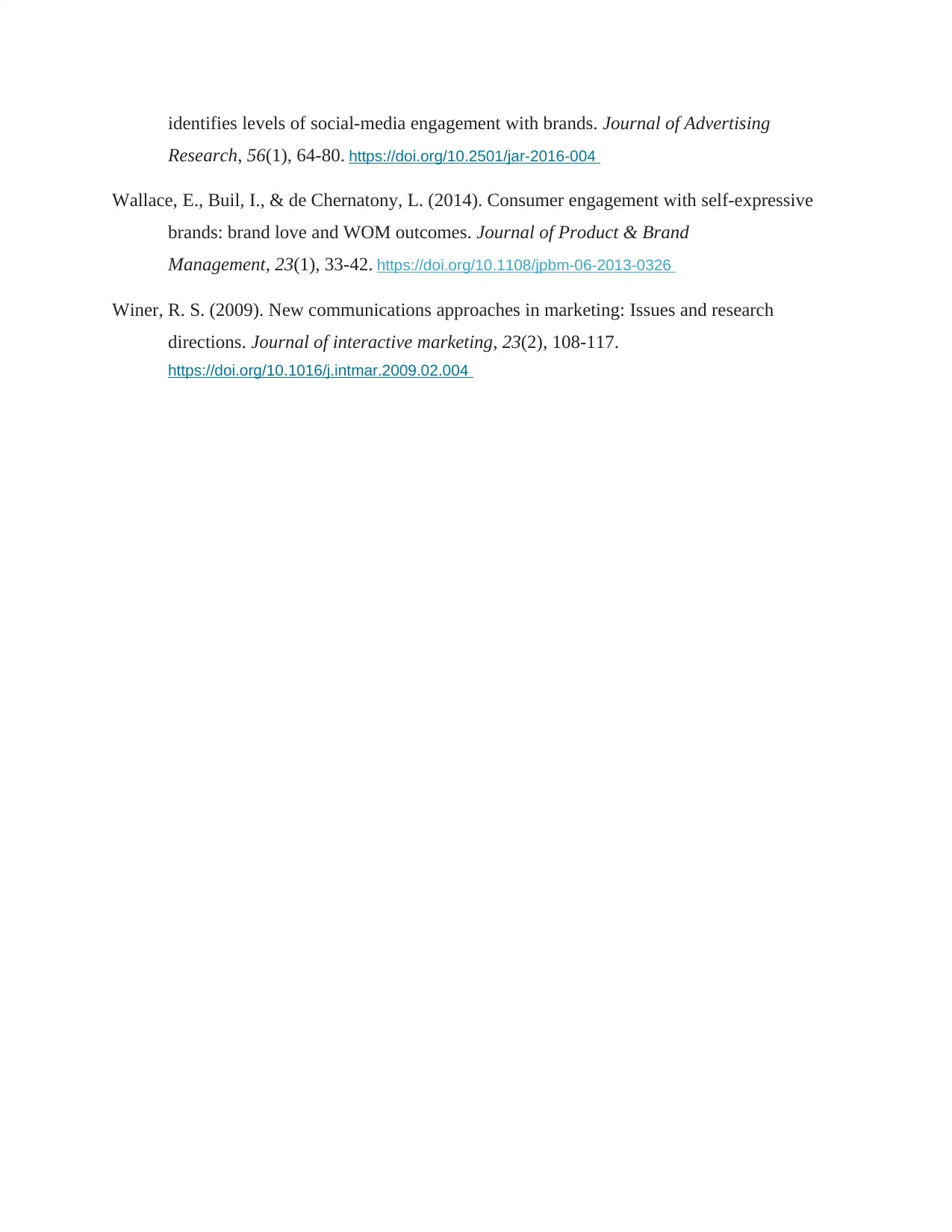
identifies levels of social-media engagement with brands. Journal of Advertising
Research, 56(1), 64-80. https://doi.org/10.2501/jar-2016-004
Wallace, E., Buil, I., & de Chernatony, L. (2014). Consumer engagement with self-expressive
brands: brand love and WOM outcomes. Journal of Product & Brand
Management, 23(1), 33-42. https://doi.org/10.1108/jpbm-06-2013-0326
Winer, R. S. (2009). New communications approaches in marketing: Issues and research
directions. Journal of interactive marketing, 23(2), 108-117.
https://doi.org/10.1016/j.intmar.2009.02.004
Research, 56(1), 64-80. https://doi.org/10.2501/jar-2016-004
Wallace, E., Buil, I., & de Chernatony, L. (2014). Consumer engagement with self-expressive
brands: brand love and WOM outcomes. Journal of Product & Brand
Management, 23(1), 33-42. https://doi.org/10.1108/jpbm-06-2013-0326
Winer, R. S. (2009). New communications approaches in marketing: Issues and research
directions. Journal of interactive marketing, 23(2), 108-117.
https://doi.org/10.1016/j.intmar.2009.02.004
1 out of 10
Related Documents
Your All-in-One AI-Powered Toolkit for Academic Success.
+13062052269
info@desklib.com
Available 24*7 on WhatsApp / Email
![[object Object]](/_next/static/media/star-bottom.7253800d.svg)
Unlock your academic potential
© 2024 | Zucol Services PVT LTD | All rights reserved.





